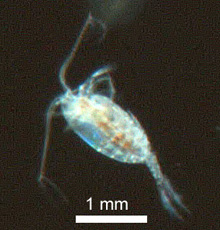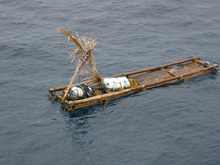Fig. 1. This bamboo raft is the float for a "bayao," which translates as "resting place." Like other fish aggregating devices (FADs) used around the world, this bayao was placed in the open ocean to attract fish, such as migrating tuna, that use it for shelter. The tuna can then be caught in nets. The raft is tied to a long nylon rope, which is weighted to the ocean floor with a cement block. About 30 feet down, coconut leaves woven together stream out from the anchor line, 10 feet in all directions, forming a mat under which fish (such as migrating tuna) hide.
Safety at Sea
October 4, 2007
Caron De Mars
Environment, Science, and Technology Officer
U.S. Embassy, Manila
We have five Philippine Navy Seals on the BRP Hydrographer Presbitero, vigilant in their watch in Mindanao waters for any approach by an unwelcome vessel. The regions of Mindanao harbor a few terrorist groups, one of which is connected to Al Queda, and a group of communist insurgents. These groups seldom affect life in Manila, but one terrorist group did set off a bomb in a Manila mall a few years ago, killing 2 people and injuring several others. The Philippine government is aware of how the lack of peace adversely affects economic development, so highly trained forces are stationed in Mindanao to stem the flow of international terrorists across its watery borders, and to keep those within its borders in check. U.S. troops conduct joint military exercises with their Filipino counterparts and provide military advisors.
The Philippine Navy Seals on our ship kept a low profile as we passed through the rough open waters of the South China Sea and wove through the Visayan Islands in the middle of the Philippines. Once we entered Mindanao waters, however, they began four-hour shifts during the day, with two on patrol around the boat and one stationed on the bridge. At night the shifts are two hours long, with one Seal on patrol and one on the bridge.
On October 3, in the Sulu Sea (11º 36.1’N, 121º 48.7’E), we passed near a fish aggregating device (FAD) so that the researchers could take a close look. This FAD (fig. 1) was locally made, and the fisherfolk will come back to this artificial reef with their nets about six months after anchoring the device in the ocean. As the Presbitero glided past the raft, the ship snagged the slack anchor rope and suddenly we saw the bamboo raft starting to follow the ship. Our alert captain immediately put the ship in neutral and two of the proficient Navy Seal divers put on their scuba tanks and dove under the ship to free the rope. When the rope was released, we went on our way, leaving the little FAD bobbing quietly and undamaged.
On October 4, we made our first stop in the Mindanao waters to test equipment, and the Seals appeared in combat camouflage, standing on the upper deck with machine guns and pistols. They are in constant communication with their commanders on shore on the various islands in Tawi-Tawi. In addition to protecting crew, visitors, and ship, the Seals also take turns driving the rubber boat that carries our SCUBA divers out for bluewater dives.
To conduct research in these waters, we feel secure with our clearances from the Philippine Coast Guard and Navy. We are grateful to have these Navy Seals with us: Lt. Artemio Pretila, Jr.; Petty Officers Edwin Martinez and Arante Valmoria; and Seamen 2nd Class Ferdinand Pinosan and Abelardo Angelo, Jr.




























